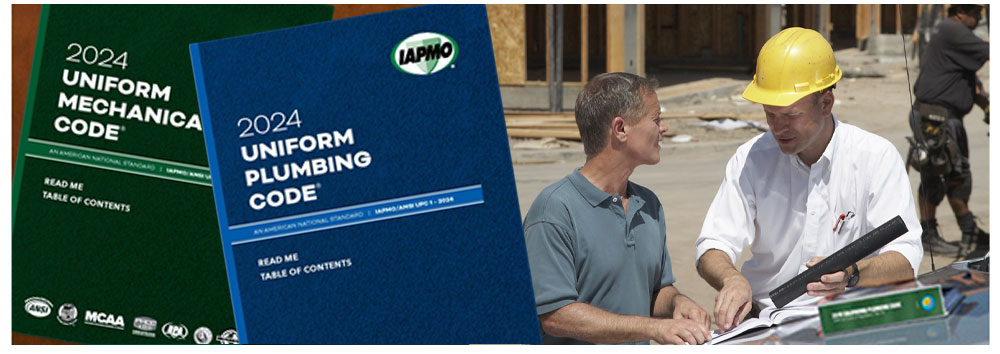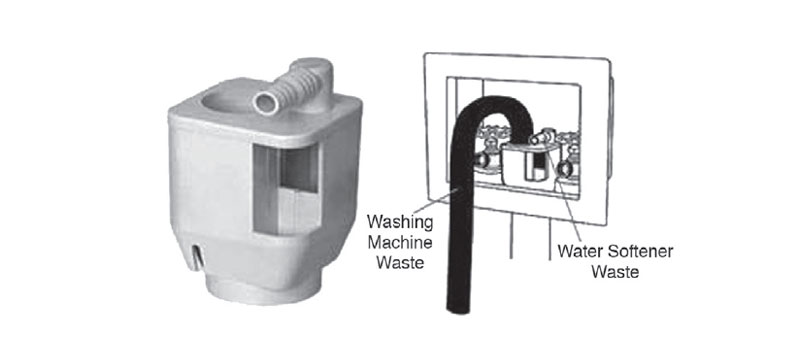April 24, 2025

From the 2024 UPC Illustrated Training Manual, Chapter 6, WATER SUPPLY AND DISTRIBUTION
611.2 Air Gap Discharge. Discharge from drinking water treatment units shall enter the drainage system through an air gap in accordance with Table 603.3.1 or an air gap device that complies with Table 603.2, NSF/ANSI 58, or IAPMO PS 65.
Most types of water treatment or soft water treatment systems have a discharge to the drainage system. This is normally a small diameter plastic tube that is sometimes placed in the standpipe of the automatic clothes washer – without an airgap. This of course is a cross connection; if the washer backs up there is a possibility of the waste reversing in the discharge tube and contaminating the water supply. This discharge line must always discharge through an airgap. There are many devices on the market that make this an easy install such as that shown in Figure 611.2a.

WATER SOFTENER AIRGAP
Any type of water treatment device that connects directly to the potable water supply shall be protected by the appropriate backflow protection device. If the water treatment device utilizes a discharge line to the drainage system, it shall discharge through an airgap (see Figure 611.2b).

INSTALLATION OF DRINKING WATER TREATMENT DEVICE WITH AIR GAP
See Learning Links http://bit.ly/2m08Sug and http://bit.ly/2lZ32JE.
From the 2024 UMC Illustrated Training Manual, Chapter 8, CHIMNEYS AND VENTS
803.1.15 Interpolation. Interpolation shall be permitted in calculating capacities for vent dimensions that fall between table entries. [NFPA 54:13.1.15]
If the installation dimensions fall between two table entries for which are defined values, the designer may calculate the in-between value. This is called interpolation. An example follows:
Table 803.1.2(1) provides the capacity of a 3-inch diameter, 15-foot high vent with zero lateral serving a natural draft appliance of 58,000 Btu/hr, and of 3-inch diameter, 20-foot high vent with zero lateral of 61,000 Btu/hr. The capacity of a 3-inch diameter, 18-foot high vent with zero lateral can be interpolated by taking 3/5 of the difference between 58,000 and 61,000 and adding it to the capacity of the 15-foot high vent. In this case, the difference is 3,000 Btu/hr, 3/5 of 3,000 is 1,800 and the capacity of the 18-foot vent is 58,800 Btu/hr.
(This is not to be considered the official position of IAPMO, nor is it an official interpretation of the Codes.)

IAPMO
IAPMO develops and publishes the Uniform Plumbing Code®,the most widely recognized code of practice used by the plumbing industry worldwide; Uniform Mechanical Code®; Uniform Swimming Pool, Spa and Hot Tub Code®; and Uniform Solar Energy, Hydronics and Geothermal Code™ — the only plumbing, mechanical, solar energy and swimming pool codes designated by ANSI as American National Standards — and the Water Efficiency Standard (WE-Stand)™. IAPMO works with government, contractors, labor force, and manufacturers to produce product standards, technical manuals, personnel certification/educational programs and additional resources in order to meet the ever-evolving demands of the industry in protecting public health and safety.
Last modified: April 24, 2025
